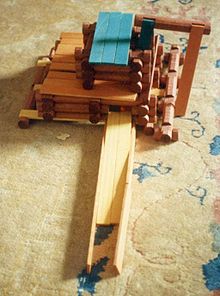Lincoln Logs
 A sawmill made from Lincoln Logs | |
| Type | Children's construction toy |
|---|---|
| Inventor(s) | John Lloyd Wright |
| Company | Basic Fun, Inc. (under license from Hasbro) |
| Country | United States |
| Availability | 1916–present |
| Materials | Wood |
| Official website | |
Lincoln Logs are an American children's construction toy consisting of square-notched miniature lightweight logs used to build small forts and buildings. They were invented around 1916 by John Lloyd Wright, second son of well-known architect Frank Lloyd Wright.[1] Lincoln Logs were inducted into the National Toy Hall of Fame in 1999. They are named after U.S. president Abraham Lincoln, who once lived in a log cabin.[2]
Starting in 2014, Lincoln Logs were manufactured by K'NEX Industries Inc. In late 2017, K'NEX was bought out by Basic Fun, Inc., of Florida. Pride Manufacturing, of Burnham, Maine, manufactures Lincoln Logs for Basic Fun, and the rights to the IP are owned by Hasbro. In 2024, Basic Fun filed for Chapter 11 bankruptcy protection. The company will use bankruptcy proceedings to repay its creditors while remaining in operation.[3]
Design
[edit]The logs measure three quarters of an inch (roughly two centimetres) in diameter. Like real logs used in a log cabin, Lincoln Logs are notched so that logs may be laid at right angles to each other to form rectangles resembling buildings. Additional parts of the toy set include roofs, chimneys, windows and doors, which bring a realistic appearance to the final creation. Later sets included animals and human figures the same scale as the buildings.[citation needed]
The toy sets were originally made of redwood, with varying colors of roof pieces. In the 1970s the company introduced sets made entirely of plastic, but soon reverted to real wood.[4]
History
[edit]
Lincoln Logs were invented sometime around 1916–1917 when John Lloyd Wright was working in Japan with his father.[5] The mold for the toy was based on the architecture of the Imperial Hotel in Tokyo, designed by the inventor's father. The foundation of the hotel was designed with interlocking log beams, which made the structure "earthquake-proof" and one of the few buildings to remain standing after the 1923 Great Kanto Earthquake that crumbled Tokyo.[6]
When he returned to the U.S., John organized The Red Square Toy Company (named after his father's famous symbol), and marketed the toy in 1918.[7] Wright was issued U.S. patent 1,351,086[8][9] on August 31, 1920, for a "Toy-Cabin Construction". Soon after, he changed the name to J. L. Wright Manufacturing. The original Lincoln Log set came with instructions on how to build Uncle Tom's Cabin as well as Abraham Lincoln's cabin. Subsequent sets were larger and more elaborate.[10] The toy was a hit, following as it did Meccano, Tinkertoys and Erector Set introduced a few years before. Lincoln Logs are believed to be the first toy to be marketed to both boys and girls and appeal to a "simple" type of creativity.[11]
In 1999, Lincoln Logs and John Lloyd Wright were entered into the National Toy Hall of Fame.[2] In September 2014, the manufacturer announced the return of production from China to the U.S.;[12] however, Lincoln Log sets with the Basic Fun logo and a copyright date of 2021 or later are now entirely manufactured in China again.[citation needed]
See also
[edit]References
[edit]- ^ "K'NEX | Lincoln Logs". Lincolnlogs.knex.com. Archived from the original on 2011-05-18. Retrieved 2011-05-23.
{{cite web}}: CS1 maint: unfit URL (link) - ^ a b "Lincoln Logs". Toy Hall of Fame. Strong National Museum of Play. Retrieved May 17, 2023.
- ^ "Toy Maker Behind Lincoln Logs, Tinker Toys Files for Bankruptcy". Bloomberg. June 28, 2024. Retrieved June 28, 2024.
- ^ "Lincoln Logs - K'Nex". K'Nex. Archived from the original on 2016-09-06. Retrieved 2014-11-16.
- ^ Carlisle, Rodney, ed. (2009). Encyclopedia of Play in Today's Society, Volume 1. SAGE Publications. p. 362. ISBN 978-1412966702.
- ^ Klein, Christopher (29 August 2018). "The Birth of Lincoln Logs". HISTORY. Retrieved 2020-03-29.
- ^ "John Kenneth Lloyd Wright". Dictionary of American Biography, Supplement 9: 1971-1975. Charles Scribner's Sons, 1994.
- ^ "Patent Public Search | USPTO". ppubs.uspto.gov.
- ^ "Toy-cabin construction".
- ^ Loewen, James. Lies Across America: What Our Historic Markers and Monuments Get Wrong. New York: The New Press, 2000, 169.
- ^ "Lincoln Logs History". made-in-chicago. 2 March 2016. Retrieved 2020-03-29.
- ^ Doig, Polly Davis (18 September 2014). "Again Made in USA: Lincoln Logs".
External links
[edit] Media related to Lincoln Logs at Wikimedia Commons
Media related to Lincoln Logs at Wikimedia Commons

